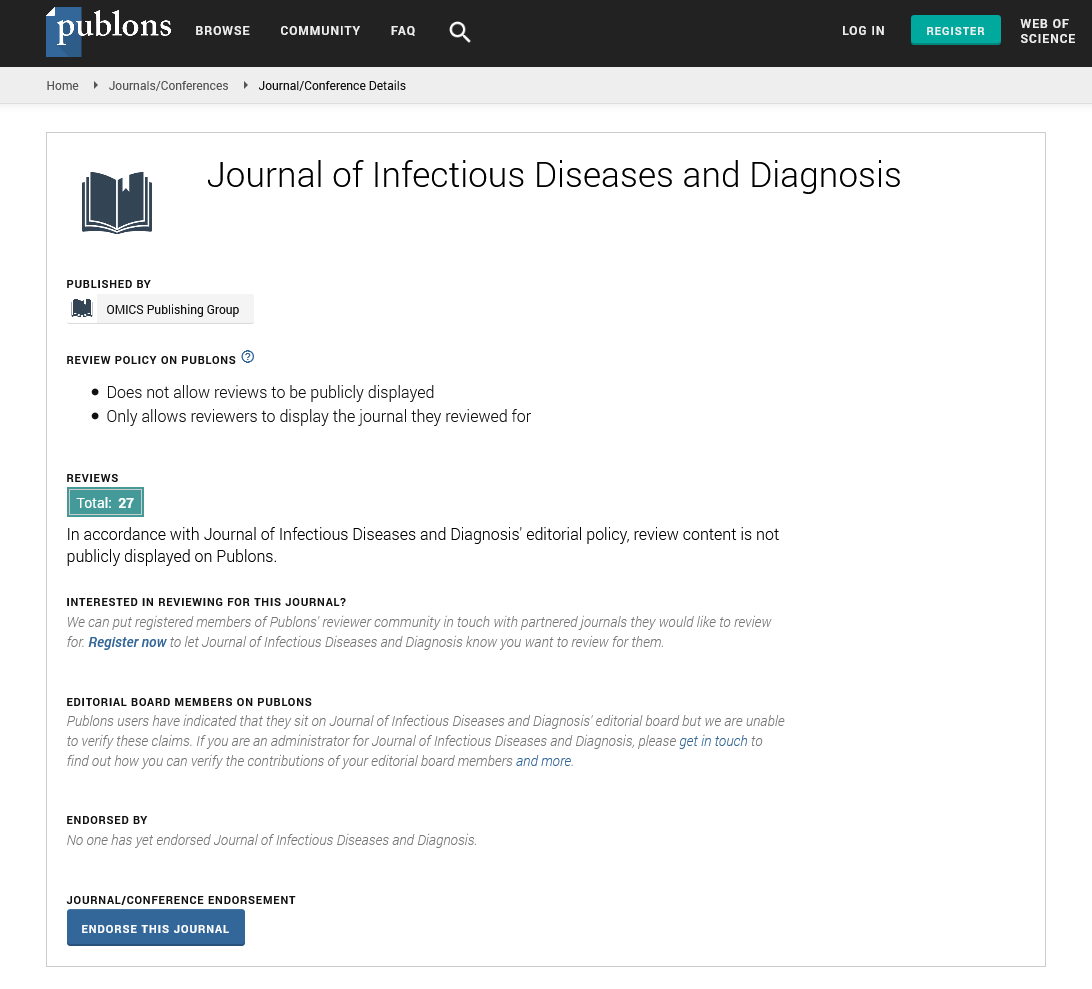Indexed In
- RefSeek
- Hamdard University
- EBSCO A-Z
- Publons
- Euro Pub
- Google Scholar
Useful Links
Share This Page
Journal Flyer

Open Access Journals
- Agri and Aquaculture
- Biochemistry
- Bioinformatics & Systems Biology
- Business & Management
- Chemistry
- Clinical Sciences
- Engineering
- Food & Nutrition
- General Science
- Genetics & Molecular Biology
- Immunology & Microbiology
- Medical Sciences
- Neuroscience & Psychology
- Nursing & Health Care
- Pharmaceutical Sciences
Perspective - (2025) Volume 10, Issue 5
Diagnostic Approaches and Epidemiological Perspectives in the Identification of Foodborne Illnesses
Rachel Moore*Received: 29-Aug-2025, Manuscript No. JIDD-25-30292; Editor assigned: 01-Sep-2025, Pre QC No. JIDD-25-30292 (PQ); Reviewed: 15-Sep-2025, QC No. JIDD-25-30292; Revised: 22-Sep-2025, Manuscript No. JIDD-25-30292 (R); Published: 30-Sep-2025, DOI: 10.35248/2576-389X.25.10.351
Description
Foodborne illnesses affect millions worldwide each year, causing symptoms that range from mild discomfort to severe, lifethreatening conditions. Proper identification of food poisoning is vital to prevent further complications and control potential outbreaks. Symptoms often include nausea, vomiting, Diarrhea, abdominal cramps and fever, although their intensity and combination can vary depending on the causative organism. Clinicians must consider both clinical presentation and patient history when assessing suspected cases. Recent consumption of undercooked meat, unpasteurized dairy, contaminated water or improperly handled produce often raises suspicion.
Laboratory testing plays a major role in confirming food poisoning and identifying the responsible pathogen. Stool sample analysis is commonly performed to detect bacteria, viruses or parasites. Bacterial cultures are a traditional method, allowing identification of species such as Salmonella, Escherichia coli and Listeria. Cultures require careful handling and specialized media to ensure accurate results and while they may take several days, they provide definitive information about the pathogen. Molecular techniques, including Polymerase Chain Reaction (PCR), have become increasingly common because they offer higher specificity and faster results. PCR allows detection of bacterial or viral genetic material and in some cases, can determine particular strains, which is important for tracking outbreaks.
Rapid tests designed for food poisoning detection are also available in some clinical settings. These tests detect toxins or antigens produced by bacteria and can provide results within hours. Although they are less sensitive than molecular methods, rapid tests are useful in situations where timely decisions are necessary, such as in emergency departments or during suspected outbreaks. Negative results, however, do not rule out infection and confirmatory tests may be required for precise identification.
Serological testing, which examines the presence of antibodies produced in response to an infection, can be useful in understanding exposure to certain pathogens over time. This approach is less effective for early diagnosis but provides insights for epidemiological studies and public health management. Identifying antibodies to toxins or bacteria can indicate previous exposure and help in monitoring trends within a community.
Emerging technologies are expanding diagnostic capabilities. Biosensor-based assays and point-of-care devices have been evaluated for rapid detection of foodborne pathogens. These approaches can detect low concentrations of bacteria or toxins and provide results without the need for complex laboratory equipment. Such developments are particularly helpful in regions with limited access to full diagnostic laboratories and may allow for faster implementation of safety measures.
Accurate identification of food poisoning also relies on proper history taking. Details about recent meals, dining locations, travel and any known outbreaks in the area provide context for selecting appropriate tests. Clinicians often combine this information with laboratory results to confirm diagnosis and guide treatment. Hydration, electrolyte replacement and supportive care are typically the primary management strategies, while antibiotics may be indicated in select bacterial cases.
Surveillance and reporting contribute to controlling foodborne illnesses. Health authorities track clusters of infection to detect potential sources and implement interventions, such as recalling contaminated products or inspecting food handling practices. Cooperation between healthcare providers, laboratories and regulatory agencies ensures timely detection of outbreaks and reduces the risk of further cases.
Despite improvements in diagnostic techniques, challenges remain. Some pathogens produce symptoms only after a delay, making timely detection difficult. Others may be present in very low quantities, which can result in false-negative results. Variability in laboratory access and resource availability further affects the speed and accuracy of diagnosis. Educating patients about hygiene, safe food handling and prompt reporting of symptoms continues to play an important role in reducing the burden of foodborne illness.
In conclusion, summary, identifying food poisoning involves a combination of careful clinical assessment, laboratory testing and epidemiological information. Bacterial culture, molecular techniques, rapid antigen detection and serology each contribute to confirming infection and understanding its spread. Continued improvements in diagnostic methods and coordinated public health efforts remain essential for protecting communities from foodborne illness.
Citation: Moore R (2025). Diagnostic Approaches and Epidemiological Perspectives in the Identification of Foodborne Illnesses. J Infect Dis Diagn. 10:351.
Copyright: © 2025 Moore R. This is an open-access article distributed under the terms of the Creative Commons Attribution License, which permits unrestricted use, distribution and reproduction in any medium, provided the original author and source are credited.

